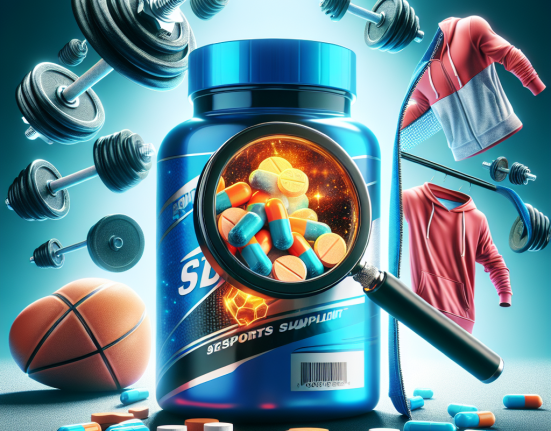-
Table of Contents
Side Effects of Trenbolone Tablets in Athletes
Trenbolone is a synthetic anabolic-androgenic steroid (AAS) that has gained popularity among athletes and bodybuilders for its ability to increase muscle mass and strength. However, like any other performance-enhancing drug, trenbolone comes with potential side effects that athletes should be aware of before using it. In this article, we will discuss the side effects of trenbolone tablets in athletes and provide evidence-based information to help athletes make informed decisions about its use.
What is Trenbolone?
Trenbolone is a modified form of the naturally occurring hormone testosterone. It was first developed in the 1960s for veterinary use to promote muscle growth in livestock. However, it has since been banned for use in food-producing animals due to its potential health risks. Trenbolone is available in various forms, including tablets, injections, and implants, and is commonly used by athletes and bodybuilders to enhance their physical performance and appearance.
How Does Trenbolone Work?
Trenbolone works by binding to androgen receptors in the body, which stimulates protein synthesis and increases nitrogen retention in the muscles. This leads to an increase in muscle mass and strength. Trenbolone also has anti-catabolic properties, meaning it can prevent the breakdown of muscle tissue, allowing athletes to train harder and recover faster.
Side Effects of Trenbolone Tablets
While trenbolone may offer significant benefits for athletes, it also comes with potential side effects that can be harmful to their health. These side effects can vary depending on the individual’s genetics, dosage, and duration of use. Some of the most common side effects of trenbolone tablets in athletes include:
1. Cardiovascular Effects
Trenbolone can have a negative impact on the cardiovascular system, increasing the risk of heart disease and stroke. It can cause an increase in blood pressure, cholesterol levels, and heart rate, which can lead to serious health complications. A study by Hartgens and Kuipers (2004) found that the use of AAS, including trenbolone, was associated with an increased risk of cardiovascular events in athletes.
2. Hormonal Imbalances
Trenbolone can disrupt the body’s natural hormone balance, leading to a range of side effects. It can suppress the production of testosterone, which can result in decreased libido, erectile dysfunction, and testicular atrophy. Trenbolone can also cause an increase in estrogen levels, leading to gynecomastia (enlarged breast tissue) in men.
3. Liver Toxicity
Like other AAS, trenbolone is metabolized by the liver, which can cause liver damage and dysfunction. A study by Kicman (2008) found that the use of AAS, including trenbolone, can lead to cholestasis, a condition where the flow of bile from the liver is blocked, causing liver damage.
4. Psychological Effects
Trenbolone can also have psychological effects on athletes, including mood swings, aggression, and irritability. These effects are commonly referred to as “roid rage” and can lead to violent and impulsive behavior. A study by Pope and Katz (1994) found that AAS use was associated with increased aggression and hostility in athletes.
5. Other Side Effects
In addition to the above, trenbolone can also cause other side effects, including acne, hair loss, and sleep disturbances. It can also have a negative impact on the immune system, making athletes more susceptible to infections and illnesses.
Managing Side Effects of Trenbolone
While the side effects of trenbolone can be concerning, there are ways to manage and minimize them. The most effective way to reduce the risk of side effects is to use trenbolone under the supervision of a healthcare professional and follow recommended dosages. It is also essential to undergo regular health check-ups to monitor any potential health complications.
In addition, athletes can also take steps to support their overall health and well-being while using trenbolone. This includes maintaining a healthy diet, staying hydrated, and getting enough rest and recovery time. It is also crucial to avoid the use of other substances, such as alcohol and recreational drugs, which can increase the risk of side effects.
Conclusion
Trenbolone is a powerful performance-enhancing drug that can offer significant benefits for athletes. However, it also comes with potential side effects that can be harmful to their health. It is essential for athletes to understand the potential risks associated with trenbolone use and take necessary precautions to manage and minimize these risks. By using trenbolone responsibly and under the guidance of a healthcare professional, athletes can reap its benefits while minimizing the potential for side effects.
References
Hartgens, F., & Kuipers, H. (2004). Effects of androgenic-anabolic steroids in athletes. Sports Medicine, 34(8), 513-554.
Kicman, A. T. (2008). Pharmacology of anabolic steroids. British Journal of Pharmacology, 154(3), 502-521.
Pope, H. G., & Katz, D. L. (1994). Psychiatric and medical effects of anabolic-androgenic steroid use. A controlled study of 160 athletes. Archives of General Psychiatry, 51(5), 375-382.







